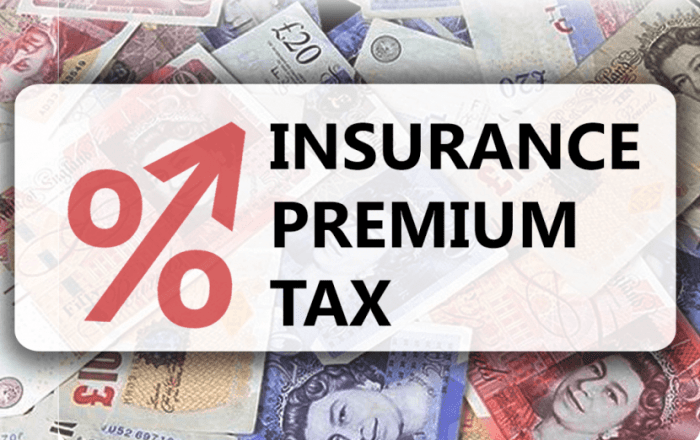Premium taxes on insurance, a seemingly obscure aspect of the financial landscape, significantly influence both insurance providers and policyholders. This exploration delves into the intricacies of premium taxes, examining their definition, impact on various stakeholders, and comparison with other insurance-related levies. We will analyze how these taxes affect profitability, pricing, and ultimately, the cost of insurance for consumers.
From the perspective of insurance companies, premium taxes represent a considerable operational expense. Understanding how these taxes are levied, and the strategies companies employ to manage their impact, is crucial. Conversely, for policyholders, premium taxes translate to a direct, albeit often unnoticed, increase in insurance premiums. This analysis aims to shed light on this often-overlooked financial mechanism and its consequences.
Impact on Insurance Companies

Premium taxes significantly impact the financial health and operational strategies of insurance companies. These taxes, levied on premiums received, directly reduce an insurer’s profitability and influence key business decisions related to pricing, product development, and overall risk management. Understanding this impact is crucial for both insurers and regulators alike.
Premium taxes directly reduce an insurance company’s net income. The tax burden represents a fixed cost that must be factored into the overall cost of doing business. This reduction in profit margin can affect the company’s ability to invest in growth initiatives, improve customer service, or enhance its technological infrastructure. The magnitude of this impact varies depending on the specific tax rate and the insurer’s overall premium volume.
Profitability and Premium Taxes
The effect of premium taxes on profitability can be substantial. A higher premium tax rate translates to a lower net profit margin. For instance, if an insurance company has a 10% profit margin before premium taxes and faces a 2% premium tax rate, its profit margin shrinks to 8%. This seemingly small reduction can have a significant cumulative effect over time, particularly for larger insurers with substantial premium volumes. Furthermore, the competitive landscape necessitates insurers to maintain a certain level of profitability to attract investors and remain viable in the market. Premium taxes directly constrain the ability to achieve these targets.
Mitigation Strategies Employed by Insurance Companies
Insurance companies employ various strategies to offset the impact of premium taxes. These strategies include careful underwriting to minimize losses and maximize profitability, efficient claims management to reduce payouts, strategic investment of assets to generate additional returns, and diversification of product offerings to spread risk and revenue streams. They may also lobby for lower tax rates or explore opportunities in states with more favorable tax environments. Pricing strategies, including dynamic pricing models that account for various risk factors and premium tax implications, are also implemented.
Influence on Insurance Pricing and Product Offerings
Premium taxes directly influence insurance pricing. Insurers must factor the tax into their pricing calculations to ensure profitability. This often results in higher premiums for consumers. Furthermore, the tax burden can impact product offerings. Insurers might adjust product features or benefits to maintain profitability within the constraints of premium taxes. For example, they might reduce coverage limits or introduce higher deductibles to lower the overall premium cost while maintaining their profit margins after accounting for the tax liability.
Hypothetical Scenario: Premium Tax Increase
Consider a hypothetical insurance company, “ABC Insurance,” with annual premiums of $100 million and a 10% profit margin before taxes. If the premium tax rate increases from 2% to 4%, ABC Insurance’s tax liability would increase from $2 million to $4 million. This would reduce its net profit by $2 million, shrinking its profit margin from 10% to 8%. This decrease in profitability could lead to reduced investment in new technologies, decreased marketing budgets, or even potential layoffs, depending on the company’s financial resilience and overall strategic planning. The company might also respond by raising premiums to offset the increased tax burden, potentially leading to customer dissatisfaction and increased competition.
Comparison with Other Insurance Taxes and Fees

Premium taxes represent only one facet of the broader landscape of insurance taxation. Understanding how premium taxes compare to other levies provides a more comprehensive view of their impact on both insurers and consumers. This section will analyze several other common insurance-related taxes and fees, highlighting their similarities and differences with premium taxes.
Types of Insurance-Related Taxes and Fees
Several different taxes and fees can impact the insurance industry, each with unique characteristics affecting insurers and policyholders differently. These include premium taxes, state-mandated assessments, and federal excise taxes. Understanding these distinctions is crucial for a holistic understanding of the insurance cost structure.
Comparison of Insurance-Related Taxes and Fees
The following table compares premium taxes with other common insurance-related taxes and fees, illustrating the varying impacts on the insurance industry and consumers. The differences in tax base, application, and ultimate impact are significant and warrant careful consideration.
| Tax/Fee Type | Tax Base | Impact on Insurers | Impact on Consumers |
|---|---|---|---|
| Premium Tax | Insurance premiums written | Direct cost increase, potentially affecting profitability and competitiveness. Can be a significant component of operating expenses. | Indirect cost increase, reflected in higher premiums. The impact varies depending on the tax rate and the type of insurance. |
| State-Mandated Assessments | Premiums written or claims paid (varies by state and assessment) | Additional cost imposed to fund specific state programs (e.g., guaranty funds, catastrophe reserves). Can be unpredictable and vary significantly between states. | Indirect cost increase, often passed on to consumers through higher premiums. The impact is highly variable depending on the state and the specific assessment. |
| Federal Excise Tax | Specific insurance products (e.g., certain types of life insurance) | Direct cost increase affecting profitability, particularly for insurers specializing in taxed products. Can influence product design and pricing strategies. | Indirect cost increase, reflected in higher premiums for the affected insurance products. The impact is limited to consumers purchasing specific types of insurance. |
Advantages and Disadvantages of Different Approaches to Insurance Taxation
Different approaches to insurance taxation present various advantages and disadvantages for both the insurance industry and consumers. A balanced approach is crucial to ensure the solvency and stability of the insurance sector while minimizing the burden on policyholders. For instance, a high premium tax can stifle competition and innovation, potentially limiting consumer choice and increasing prices. Conversely, a system relying heavily on state-mandated assessments may lack transparency and predictability, leading to sudden cost increases for insurers. The optimal approach requires careful consideration of the specific context and policy goals.
End of Discussion

In conclusion, premium taxes on insurance are a complex issue with far-reaching consequences for insurance companies, policyholders, and governments alike. While necessary for funding public services, understanding their impact on pricing, affordability, and overall market dynamics is paramount. Further research and transparent policy discussions are needed to ensure a fair and equitable system that balances the needs of all stakeholders.
FAQ Guide
What types of insurance are typically subject to premium tax?
Most types of insurance policies are subject to premium tax, including auto, home, health, life, and commercial insurance. However, specific exemptions may exist depending on the jurisdiction.
Who collects the premium tax?
Premium taxes are typically collected by the state or national government where the insurance policy is issued.
Can premium tax rates vary significantly between states or countries?
Yes, premium tax rates vary considerably depending on the jurisdiction and type of insurance. Some regions may have higher rates to fund specific public programs.
Are there any deductions or credits available to reduce premium tax liability for insurance companies?
Some jurisdictions offer deductions or credits for specific insurance activities or types of insurance policies. This varies widely by location and is subject to change.